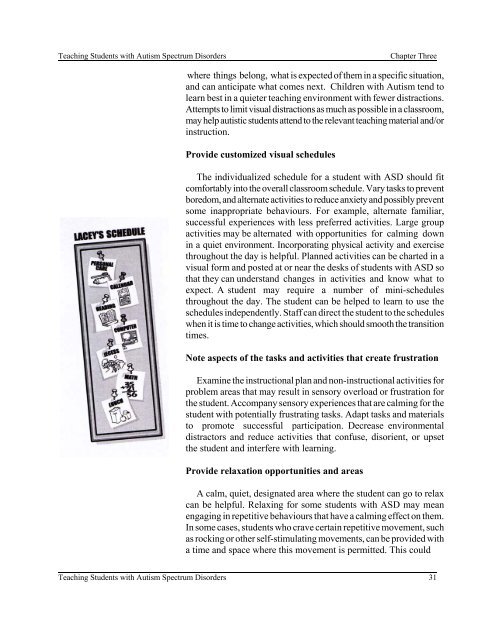Teaching Students with Autism Spectrum Disorders
Teaching Students with Autism Spectrum Disorders
Teaching Students with Autism Spectrum Disorders
You also want an ePaper? Increase the reach of your titles
YUMPU automatically turns print PDFs into web optimized ePapers that Google loves.
<strong>Teaching</strong> <strong>Students</strong> <strong>with</strong> <strong>Autism</strong> <strong>Spectrum</strong> <strong>Disorders</strong> Chapter Three<br />
where things belong, what is expected of them in a specific situation,<br />
and can anticipate what comes next. Children <strong>with</strong> <strong>Autism</strong> tend to<br />
learn best in a quieter teaching environment <strong>with</strong> fewer distractions.<br />
Attempts to limit visual distractions as much as possible in a classroom,<br />
may help autistic students attend to the relevant teaching material and/or<br />
instruction.<br />
Provide customized visual schedules<br />
The individualized schedule for a student <strong>with</strong> ASD should fit<br />
comfortably into the overall classroom schedule. Vary tasks to prevent<br />
boredom, and alternate activities to reduce anxiety and possibly prevent<br />
some inappropriate behaviours. For example, alternate familiar,<br />
successful experiences <strong>with</strong> less preferred activities. Large group<br />
activities may be alternated <strong>with</strong> opportunities for calming down<br />
in a quiet environment. Incorporating physical activity and exercise<br />
throughout the day is helpful. Planned activities can be charted in a<br />
visual form and posted at or near the desks of students <strong>with</strong> ASD so<br />
that they can understand changes in activities and know what to<br />
expect. A student may require a number of mini-schedules<br />
throughout the day. The student can be helped to learn to use the<br />
schedules independently. Staff can direct the student to the schedules<br />
when it is time to change activities, which should smooth the transition<br />
times.<br />
Note aspects of the tasks and activities that create frustration<br />
Examine the instructional plan and non-instructional activities for<br />
problem areas that may result in sensory overload or frustration for<br />
the student. Accompany sensory experiences that are calming for the<br />
student <strong>with</strong> potentially frustrating tasks. Adapt tasks and materials<br />
to promote successful participation. Decrease environmental<br />
distractors and reduce activities that confuse, disorient, or upset<br />
the student and interfere <strong>with</strong> learning.<br />
Provide relaxation opportunities and areas<br />
A calm, quiet, designated area where the student can go to relax<br />
can be helpful. Relaxing for some students <strong>with</strong> ASD may mean<br />
engaging in repetitive behaviours that have a calming effect on them.<br />
In some cases, students who crave certain repetitive movement, such<br />
as rocking or other self-stimulating movements, can be provided <strong>with</strong><br />
a time and space where this movement is permitted. This could<br />
<strong>Teaching</strong> <strong>Students</strong> <strong>with</strong> <strong>Autism</strong> <strong>Spectrum</strong> <strong>Disorders</strong> 31

















